Bananas are one of the most popular fruits in the world. They are very healthy and contain several important nutrients. Grow in hot tropical countries.
Thanks to this, we can enjoy them all year round: hot summers and cold winter. They are loved by children and adults all over the world.
People usually know that bananas are very nutritious, but many wonder how many calories and carbohydrates they actually contain. This article contains answers to these questions.
However, different sizes contain different amounts of calories.
Below is the calorie content of standard banana sizes:
- Extra small (less than 15 cm, 81 grams): 72 calories.
- Small (15-17 cm, 101 grams): 90 calories.
- Medium (17-19 cm, 118 grams): 105 calories.
- Large (19-21 cm, 136 grams): 121 calories.
- Extra large (21 cm or more, 152 g): 135 calories.
- Sliced (1 cup, 150 g): 134 calories.
- Mashed (1 cup, 225 grams): 200 calories.
If you're not sure about the size of your banana, you should know that a medium-sized banana contains about 95 calories.
93% of a banana's calories come from carbohydrates, 4% from protein, and 3% from fat.
How many carbs are in a banana?
A banana is almost entirely made up of water and carbohydrates.
Carbohydrate watchers are interested in knowing the carbohydrate content of food.
Small (less than 15 cm, 81 g): 19 grams.
Small (15-17 cm, 101 g): 23 grams.
Medium (17-19 cm, 118 grams): 27 grams.
Large (19-21 cm, 136 grams): 31 grams.
Extra large (21 cm or more, 152 g): 35 grams.
Chopped (1 cup, 150g): 34g
Mashed (1 cup, 225g): 51g
Bananas also contain 2-4 grams of fiber, depending on size. You can subtract 2-4 grams if you are looking for "net" carb content (net carbs = total carbs - fiber).
Also, the ripeness of a banana can affect its carbohydrate content.
How much and what do green and unripe bananas contain?
Generally speaking, green or unripe bananas contain less digestible carbohydrates than ripe ones.
A medium-sized fruit contains about 25 grams of carbohydrates, possibly even less if the banana is unripe (green).
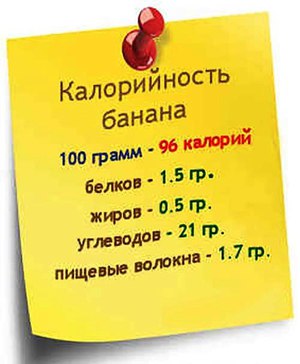
Unripe (green) bananas contain more resistant starch.
The main nutrient in them is carbohydrates, but the composition of carbohydrates changes dramatically during ripening.
Unripe fruits contain a large number of starch.
Because the starch in a banana is converted to sugar during ripening, yellow fruits contain less resistant starch than green fruits. Indeed, the sustainable starch content is completely ripe banana is less than 1%.
Resistant starch is a type of digestible carbohydrate that reaches the colon undigested, where it feeds friendly gut bacteria.
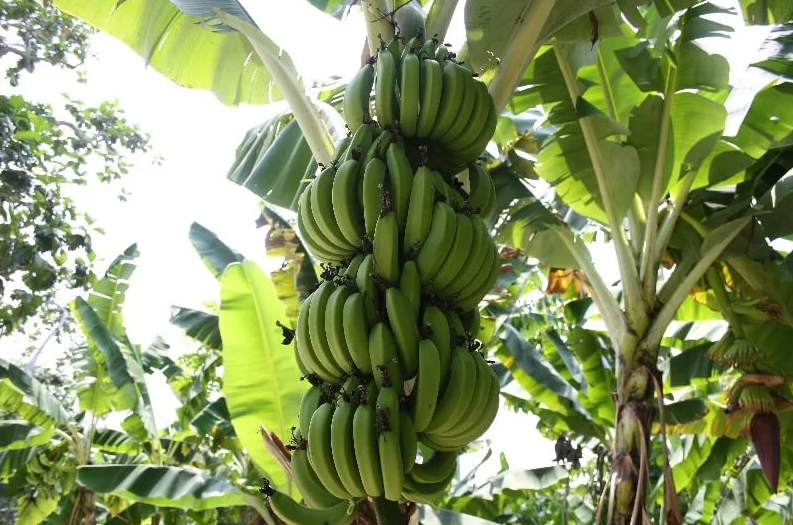
When bacteria digest resistant starches, they form gases and short-chain fatty acid(SCFA) which are important for health.
About 95% of these SCFAs are then rapidly taken up by the cells in the colon and used by the body for energy.
Bottom Line: Unripe bananas are high in resistant starch, which escapes the stomach and feeds friendly bacteria in the gut, which uses them to make short-chain fatty acids.
Calorie content, nutritional value and chemical composition
One medium banana contains:
- Fiber: 3.1 grams.
- Vitamin B6: 22% of the RDI.
- Vitamin C: 17% of the RDI.
- Manganese: 16% of RDI.
- Potassium: 12% of RDI.
- Magnesium: 8% of RDI.
- Folic acid: 6% of the RDI.
- Copper: 5% of RDI.
- Riboflavin (vitamin B2): 5% of the RDI.
Bananas are delicious and nutritious. They create wonderful, healthy and low-calorie food.
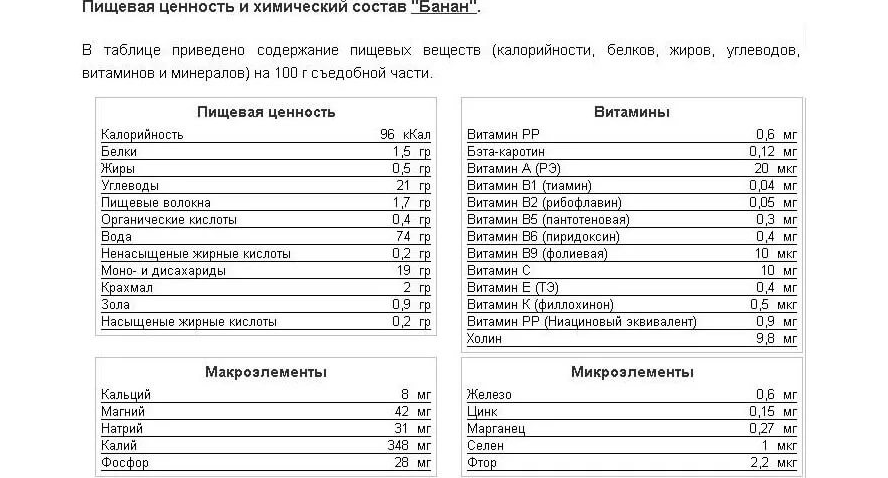
Bottom Line: Bananas contain good amounts of fiber, vitamin B6, manganese, vitamin C, copper, and potassium.
They typically contain 72-135 calories and 19-35 grams of carbs, depending on their size.
A medium-sized banana contains about 100 calories and 25 grams of carbohydrates.
What is the benefit of a banana?

Despite the fact that Russia and the CIS countries are not regions where bananas grow, the popularity of this fruit in our area is incredible. The low price, usefulness and availability throughout the year have made the banana the most popular fruit in domestic supermarkets.
What is its energy value, how many calories, proteins, fats and carbohydrates are contained in this product, and how useful it is, we will tell all this below.
fruit facts
The fruit is native to Southeast Asia. Curious that this product is here began to be cultivated much earlier than rice or sugar cane.
Many believe that they grow on a special banana tree. But really it's not a tree, it's grass, and bananas themselves, although they are commonly called fruits, they are not. They are actually berries.
They are removed still in an immature state, and then they are allowed to ripen, then they acquire a characteristic taste and their beneficial properties, of which there are quite a lot.
Beneficial features
Banana is a highly nutritious fruit. Its calorie content is 96 kcal per 100 grams of product. It has the property of saturating the body, it is recommended to use it during heavy physical and intellectual stress. It's also a great product for sports nutrition. It contains sugar, but, unlike usual, it is quickly and easily absorbed by the body, and also gives it energy.
A lot of people love such a delicacy as dried bananas, you need to be extremely careful with them, because this the product can no longer be called dietary due to its high calorie content. When dried, the fruit becomes more nutritious.
These fruits are very useful for various diseases and for the purpose of prevention and rehabilitation So, it is recommended to use it in such cases:

And regular consumption of this product will have such an effect:
- improve mood;
- relieve sleep disturbance and improve its quality;
- relieve tension and stress.
In addition to the above, banana helps cope with disorders of the gastrointestinal tract, puts in order the process of digestion, as well as metabolism.
However, remember that only ripe fruits can have beneficial properties, but green ones are not digested very well by the body.
How are bananas used?
Beneficial features in this fruit are present due to its composition. So, in a banana there is:
- various enzymes;
- vitamins of groups C, PP, E, B;
- organic acids;
- a number of micronutrients.
They are especially rich in potassium, this microelement is especially useful for blood vessels and the heart. Scientists have come to the conclusion that one thing able to meet the daily need of our body for magnesium and potassium, and this will be enough to prevent myocardial infarction.
Most often, bananas are eaten in fresh, but it is also used as an ingredient for dishes such as:
- beer;
- marmalade;
- ice cream;
- wine.
And this is not a complete list of drinks and dishes that can be prepared on a banana basis.
The energy value of the fetus
![]() Bananas in our country have long ceased to be considered exotic products, this is one of the most affordable and popular fruits. Of these, many do delicious desserts
or simply served as a sweet cut.
Bananas in our country have long ceased to be considered exotic products, this is one of the most affordable and popular fruits. Of these, many do delicious desserts
or simply served as a sweet cut.
And bananas are very fond of those who are on diets, although the fruit is one of the most high-calorie. Quite a few fruit salads, which many consider easy, as such due to energy value fruits are not. Like banana yogurt in terms of calories, carbohydrates, fats and proteins will be superior to other meals, which are not traditionally considered dietary, for example, boiled potatoes. In 100 grams of such a salad, there are about 100-110 kilocalories.
But, despite the high energy value of such a dish, it is quite satisfying and after it you don’t feel like eating anything. The glycemic index is at the level of 70, but for the same potato this figure will be 90. Now let's find out nutritional value banana how many carbohydrates, proteins and fats are in it.
Bananas: Bju and useful substances
Banana pulp contains:
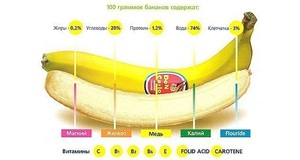
Moreover, it is worth noting that simple carbohydrates predominate, sucrose, in particular, but complex carbohydrates only up to 8 percent is present in the fetus. The remaining 65 percent of the fruit pulp is water.
As we can see, this fruit is a source of fast carbohydrates, in addition, it contains about 350 mg of potassium and 42 mg of magnesium. Thanks to this composition banana can be used as a snack after intense physical exertion, to replenish the supply of energy and vigor.
And for 100 grams of product you have:
- provitamin A and vitamin A - 2 percent of daily allowance. Beta-carotene is present 3 times more in red bananas;
- vitamins B, especially B6, which are responsible for muscle work, they also prevent the development of diabetes and remove cholesterol;
- vitamins C - 11 percent of the daily requirement;
- vitamins PP and E;
- 14 percent of the daily requirement of manganese, which is required to strengthen the immune system and improve mood;
- tryptophan is an amino acid that is needed for the synthesis of serotonin (the so-called happiness hormone).
A banana is especially good for women during PMS, tryptophan suppresses depression and bad mood, improves the general condition of the fair sex on such difficult days for them.
Is a banana harmful?
This fruit has not only useful properties, it can also be harmful. So, banana is not recommended for obesity and increased blood clotting It should also be limited to the elderly.
Is it possible to lose weight on bananas?
 Banana is a product in which it is not so much the number of calories that matters, but more nutritional properties. To put yourself in order and get the desired figure, diet must be followed on an ongoing basis. If you periodically “sit down” on strict mono-diets and quickly lose kilograms, then quit them, then you will very soon return to your previous, not the best form.
Banana is a product in which it is not so much the number of calories that matters, but more nutritional properties. To put yourself in order and get the desired figure, diet must be followed on an ongoing basis. If you periodically “sit down” on strict mono-diets and quickly lose kilograms, then quit them, then you will very soon return to your previous, not the best form.
Naturally, it is extremely difficult to follow a diet all the time and there are always risks of a “failure”. That's why recommended before every meal at least 20 minutes to eat a couple of bananas. Their nutritional value and calorie content will halve your subsequent appetite, and you will not eat as much as you would initially like.
Go to healthy eating not so difficult. Just every time you want to eat chocolate or cake, eat a banana. And your favorite dishes for breakfast or lunch can remain the same as before.
The largest amount of calories is always present in fat. If you combine the calories of a banana with the value of a fatty meal, even in a small amount , then you are unlikely to lose weight. You can drink special products that do not allow fats to be absorbed and remove them naturally. bananas in this case regulate the amount of food eaten.
Almost everyone loves this fruit, and this can be explained, because bananas are delicious and nutritious and have virtually no contraindications. However, even in them you need to observe the measure, then you will surely be able to always be in shape.
July 24, 2014 5408
It will probably be difficult to find a person who does not know about such delicious fruit like a banana.
It is considered an exotic fruit along with pineapples, coconuts and oranges.
But bananas have penetrated so deeply into our lives that they have become our family.
How much protein, carbohydrates and fats bananas contain, as well as their beneficial properties, can be found below.
What is included in this product?
In this fruit, the researchers found many sugars, among them sucrose, fructose and glucose.
Because of this, the banana is very high in calories.
Scientists claim that because of their unique composition, this product is able to provide a person with energy, which is enough for 30 minutes of work.
In addition to sugar, this product also contains vitamins: carotene, tocopherol, ascorbic acid, nicotinic acid, riboflavin and thiamine, as well as potassium, magnesium, enzymes, trace elements and other boring words that are generally uninteresting to a simple consumer.
In general, a banana is a very healthy fruit!
It is interesting, but how much protein is in one banana, if you go into numbers, then in 100 grams of a banana there are:
- 1.5 grams of proteins;
- 0.5 fat;
- 21 grams of carbohydrates;
- 0.15 mg zinc;
- 0.6 mg iron;
- 1 mcg selenium;
- 0.27 mg manganese;
- 2.2 μg fluorine.
What vitamins are in bananas?
Vitamins of groups A, B, C, E, K and, of course, vitamin PP and Beta-carotene.
How many calories are in this fruit?
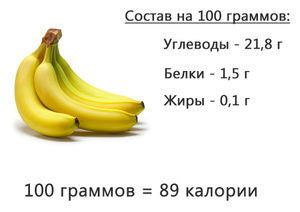
The number of calories depends on the size of the fetus, so it varies from 72 to 100.
If we take the average number, then it can be argued that 100 grams of banana contains 70-100 Kcal.
An interesting fact is that there are much more calories in a green banana - about 110.
But the leader in nutritional value is still a dry banana.
It contains approximately 297 kcal.
Application in dietetics
Nutritionists love this product very much.
Due to the fact that the banana is able to rid the body of excess water, it is widely used for weight loss.
Specialists have even developed many variants of banana diets.
According to one of them, you should eat up to two bananas before meals.
After this "ritual" you can eat whatever your heart desires, but be sure to adhere to the right diet.
Such a diet is considered not strict, it does not give quick results, and with its help it is usually prepared for more stringent tests.
For fast weight loss there is an "emergency" diet "Banana Split".
You can sit on it for no more than three days. According to her, you can only consume low-fat milk and bananas for the whole day, and then in correct proportions- "three bananas - three glasses."
Such an "abundance" of food should be divided into as many as 5 receptions.
Only drinking water is allowed.
And how did you want?
Losing weight is not easy!
Useful properties of exotic fruit and their application
Scientists have proven that if you eat 1-2 bananas daily, you will feel great.
After all, thanks to beneficial substances yellow fruit, the tone of the body, mood increases, efficiency and attention are concentrated, a person is less prone to fatigue.
It is worth noting that sumo wrestlers also have a kind of banana diet, which perfectly stimulates the growth of muscle mass.
For patients with hypertension and atherosclerosis, this fruit is perfect for unloading days due to the high content of magnesium and potassium salts.
An exotic product is also widely used in the treatment of liver diseases, nephritis, stomatitis, diapedetic bleeding and urolithiasis.
Patients with gastrointestinal diseases, doctors recommend eating bananas as a mild laxative.
They treat people with banana juice. It is especially useful in dysentery, cholera and hemorrhages (in the duodenum and stomach).
Also, this product is rich in ephedrine.
It is a tonic that can slightly lift blood pressure which stimulates the central nervous system.
This substance is able to raise the level of sugar and have an antispasmodic effect on the broncho-pulmonary muscles.
Even in the records of Avicenna, researchers find the fact that bananas prevent impotence.
It is worth introducing fruit into your diet and allergy sufferers.
For example, in the treatment of celiac disease, doctors often resort to a banana diet.
According to this diet, the norm of bananas per day is up to 10 pieces. But before you take up the treatment of your young child, consult your doctor.
Another incredible property of bananas, which is confirmed by science, is its anticonvulsant and sedative effect.
People have learned to use green, still unripe bananas.
They are first crushed, then dried, then applied to diabetic leg ulcers.
Separately, it is worth remembering the peel
It is also used in the treatment of various diseases.
For example, to relieve migraine pain, it is enough to apply a peel compress to the forehead and back of the head.
And hypertension can be overcome without any problems by drinking a decoction of fresh peel.
The inner part of the peel of a ripe fruit does an excellent job with burns, boils and rashes when applied to the affected areas.
Medical studies have confirmed that banana peels can be used to treat plantar warts.
To do this, the peel is tied with the inside to the wart, before washing the feet it is removed and later replaced with a new one.
The treatment process is quite long, but effective.
As already mentioned, this tropical fruit It has many useful properties, thanks to which you can heal some ailments.
- hypertension;
- liver disease;
- nephritis;
- stomatitis;
- diapedetic bleeding;
- urolithiasis disease;
- gastrointestinal diseases;
- dysentery;
- cholera;
- hemorrhages in the stomach or duodenum;
- impotence;
- allergy;
- epilepsy;
- hysteria;
- diabetic ulcers;
- migraine;
- burns;
- abscesses;
- rash;
- plantar warts;
and, of course, being overweight.
As you can see, such a seemingly simple fruit has many advantages.
Its beneficial properties continue to be explored today.
It is useful for both the healthy and the sick.
Therefore, if you have no contraindications, eat and be healthy!
Video dessert
In a short video, you will learn useful information about such a valuable fruit as a banana.
A green banana contains more starch, but as it ripens, it turns into sugar - therefore, it carries carbohydrates. Bananas are also easy on the stomach, which is another reason why they are a major source of energy for athletes.
Not all bananas are the same nutritional value, since large fruits, unlike small ones, contain more calories, carbohydrates and other nutrients. 1 medium-sized banana usually contains about 100 calories. This chart will help you better understand how many calories and carbohydrates are in 1 banana:
- Very small(less than 15 cm, 81 g): 72 calories, 19 g carbohydrates.
- Small(15-18cm, 101g): 90 calories, 23g carbs.
- Average(18-20cm, 118g): 105 calories, 27g carbs.
- Big(20-23 cm, 136 g): 121 calories, 31 g carbs.
- Very big(over 23 cm, 152 g): 135 calories, 35 g carbs.
- Sliced(1 bowl, 150g): 134 calories, 34.2g carbs.
- banana puree(1 bowl, 225g): 200 calories, 51.3g carbs.
How many carbs are in a banana and what type of carbs are in it
Part of the banana family ( Musaceae) grow from 3 to 8 meters in height. Bananas grow in clusters of 50 to 150 bananas per giant bunch. Each giant cluster includes many smaller clusters. Each smaller bunch (often referred to as a bunch of bananas) can contain 10 to 25 bananas.
The carbohydrates in bananas are not much different from other carbohydrates - the difference is in the fiber. While a banana is high in carbs (more than an orange, in fact), it also contains fiber and starch, which can make you feel fuller for longer, as carbs are digested much faster and promote satiety. Fiber helps slow the absorption of carbohydrates into the bloodstream.
However, it is important to note that bananas may have a greater effect on blood sugar levels than oranges or strawberries. This means they have more carbs and ultimately have a higher glycemic index and glycemic load. The glycemic index and glycemic load measure blood sugar levels, which can be really important for people with diabetes. However, bananas are considered by many to be a smart choice for maintaining proper blood sugar levels.
Bananas are also popular with anyone on a carb diet, such as when you eat more carbs on certain days. So, how many grams of carbs per day do you need, and how many carbs should you get from bananas? If you are physically active, about 40% of your calories should come from carbohydrates, another 30% from protein, and another 30% from fat.
You need to get between 500 and 800 calories from carbohydrates daily - for this you need to consume 150 to 200 grams of carbohydrates per day:
- 200 g of carbohydrates is the maximum amount.
- 120 g of carbohydrates is the minimum (ideal for people who want to lose weight).
Bananas are good source getting some from these carbs - 1-2 per day depending on the size of the banana and the amount of carbs you get from other sources.
What are the Benefits of Carbohydrates in a Banana
The carbohydrates in bananas not only nourish your body, but also provide benefits.
1. Provide Energy and Improve Cellular Function
Even with popular low-carbohydrate diets, carbohydrates are still the main source of energy for the human body. When you eat, your body takes in food and breaks it down into sugars and starches so it can be absorbed. When this happens, sugars and starches are converted into glucose (blood sugar). This is important because glucose is essential for your body to function properly. It supports the normal functioning of the brain and all organs, giving energy to the whole body, which makes it possible to solve everyday tasks, work, train and simply live.
Also, have you heard of adenosine triphosphate (ATP)? ATP is found in the cells of the body and is a key source of energy. ATP is formed by a natural chemical reaction process after digestion and can be formed from carbohydrates, proteins and fats. But what is important is that cells use ATP to ensure proper cellular function.
A number of plant and animal foods provide ATP, and bananas are one of them. Bananas have plant cells that store ATP, so when you eat a banana, it is converted into glucose and then used to make ATP when the body needs it.
2. Help with digestion
As noted above, bananas are actually considered a low glycemic index (GI) food. GI measures the effect of food on sugar levels in the body. So, how can a super-sweet banana be in the low-cost food category? glycemic index? The answer lies in fiber dietary fiber). Fiber helps maintain the normal speed of the digestion process. This allows carbohydrates to be converted into simple sugars at a pace that provides a much easier digestion process.
In addition, bananas contain pectins. Pectin is a fairly complex type of fiber - some pectins are water soluble and some are not. During the fruit ripening process, the water-soluble pectins increase, causing the banana to become softer as it ripens. This process increases fructose levels, which help stabilize the rate of “carb breakdown”—another reason why it’s best to eat ripe bananas over green ones.
The fructooligosaccharides (FOS) in bananas make digestion even smoother. FOS are fructose-filled carbohydrates that are not normally broken down by the enzymes found in the digestive system. They actually move further down the GI tract and are eventually metabolized by beneficial bacteria. Therefore, maintaining a normal gut microflora and the presence of bacteria such as bifidobacteria in the lower intestine can actually benefit the health of the entire digestive tract.
3. Support the mental and physical condition of the body of athletes
Research has been done on runners to understand what they prefer to eat before, during, and after an endurance run. It appears that bananas were definitely preferred during the race, probably for both energy from glucose and easier digestion, although the reasons were not specified in the study.
Another study carried out in Cornell University with athletes doing 90 minutes of running followed by 90 minutes of cycling or cycling to exhaustion. Athletes were given a placebo, a banana mix, or a regular banana. A study has shown that a regular banana is very effective in increasing stamina.
Magazine Journal of the International Society of Sports Nutrition studied young female gymnasts aged 12-14 who were given carbohydrates to evaluate the performance of fatigued athletes. The scientists found that those who were given carbohydrates were more focused and had fewer mistakes and falls during exercise.
Bananas are a great source of energy for athletes or any physically active person, but they are best consumed an hour or two before physical activity. The reason for this is that eating bananas right before the start of physical work can slow down your performance and make you feel some discomfort as the body diverts blood flow to the stomach for digestion and absorption of nutrients.
How many carbs are in a banana and how many carbs are in a plantain
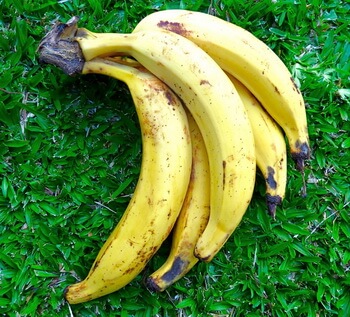
With all this banana talk, you might be wondering about the difference between plantain carbs (large vegetable bananas) and banana carbs. So let's set a record by learning a little about plantain.
This makes sense since plantains are in the same family as bananas and look the same. However, plantains contain more starch than bananas. In most cases, plantains are eaten cooked, unlike bananas, which are mostly eaten raw.
How many carbohydrates and calories in a banana (raw):
- Chopped (1 bowl, 150g): 134 calories, 34.2g carbs.
- Banana puree (1 bowl, 225g): 200 calories, 51.3g carbs.
How many carbohydrates and calories in plantain (cooked):
- Chopped (1 bowl, 154g): 179 calories, 48g carbs.
- Plantain puree (1 bowl, 200g): 232 calories, 62.3g carbs.
Precautionary measures
Bananas are an excellent source of energy and nutrients. They have many health benefits, which you can learn about here - 10 Health Benefits of Bananas - Life Without Pills. If you have an allergic reaction to bananas, stop eating them immediately and contact your doctor. We are not aware of any health risks associated with bananas, but if too much sugar is causing you headaches or weight gain, or if you have a potassium reaction, consume these fruits in moderation and/or see a doctor.
Sweet and nutritious bananas with pleasant taste able to give strength, cheer up and satisfy hunger. These properties are due chemical composition popular berry.
How many carbs are in bananas
The nutritional composition of a banana is mainly represented by carbohydrates, which makes the berry unacceptable for consumption on strict diets. The value index per 100 g is about 96 kcal, the weight of one medium-sized fruit is 160 g, respectively, its energy value is 153 kcal without peel. Read more in our publication. In order not to gain extra pounds, it is recommended to eat bananas only in the morning.
One large banana contains about 34 grams of carbohydrates. In 100 g - 21.8 g, which is 7% of the daily intake.
it fast carbohydrates, which are more likely to be absorbed, therefore, when dieting, it is better to avoid foods containing them. 19 g of the total amount are represented by simple carbohydrates (mainly fructose), the rest (2.8 g) is starch, which belongs to the complex group.
One ripe fruit has about 0.3 g of fat, 100 g - one tenth less (1% of the daily requirement). The majority are saturated fat, smaller - polyunsaturated and monounsaturated. The calorie content is affected by the size of the fruit, its ripeness, variety and carbohydrates that make up the composition. Their pulp contains at least 25%. Therefore, the amount of fat present in the edible part has practically no effect on the energy value.
Proteins in banana
The amount of protein in one banana is at least 2 g, in 100 g - approximately 1.5 g, which is 3% of the daily intake of a person with an average level of activity aged 18 to 39 years. The proteins in the pulp are represented by essential and non-essential amino acids.
By consuming the fruit 2-3 times a week, you can get a boost of energy, improve mood, and raise the tone of the body.
This is achieved thanks to the protein tryptophan, which is converted into serotonin during a chemical reaction. Eating 3 or 4 fruits during snacks, you can saturate the body with protein, play sports without overwork and recuperate after a busy day.
The incredible feeling of satiety that remains after eating sweet tropical fruits is achieved due to the significant fiber content in the berry. Quantity in 100 g = 1.7 g, which is 7% of daily allowance. Fiber improves organ function digestive system, helps with mild intestinal disorders, as well as with many pathologies of the stomach. To maintain strength and shape, foods rich in fiber are eaten by athletes after prolonged physical exertion. In addition, the pulp contains many trace elements, beta-carotene and vitamins.
BJU bananas - nutritional composition
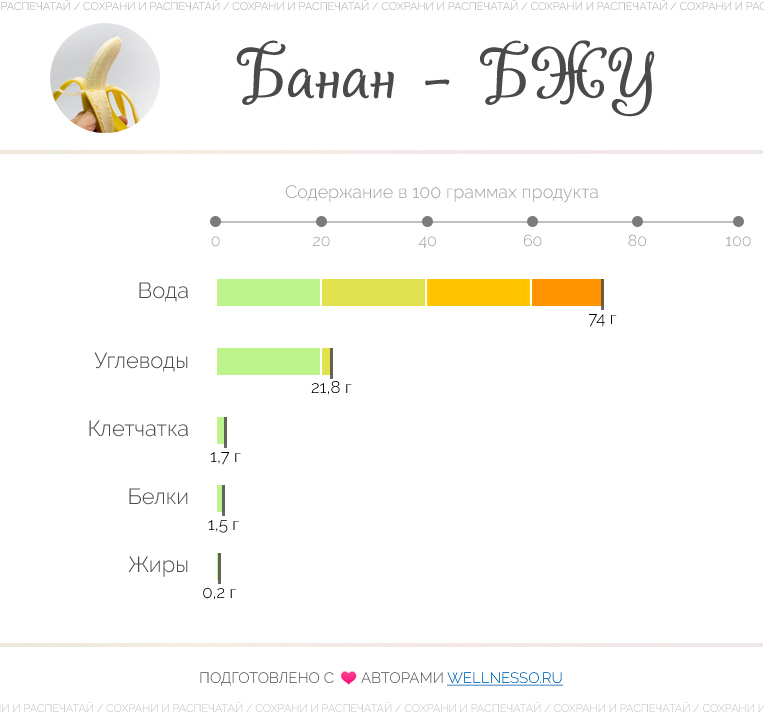
Delicious fruit is nutritious and beneficial for the body. Properly including it in the diet, you can gain strength with large physical activity And don't worry about gaining extra pounds.


